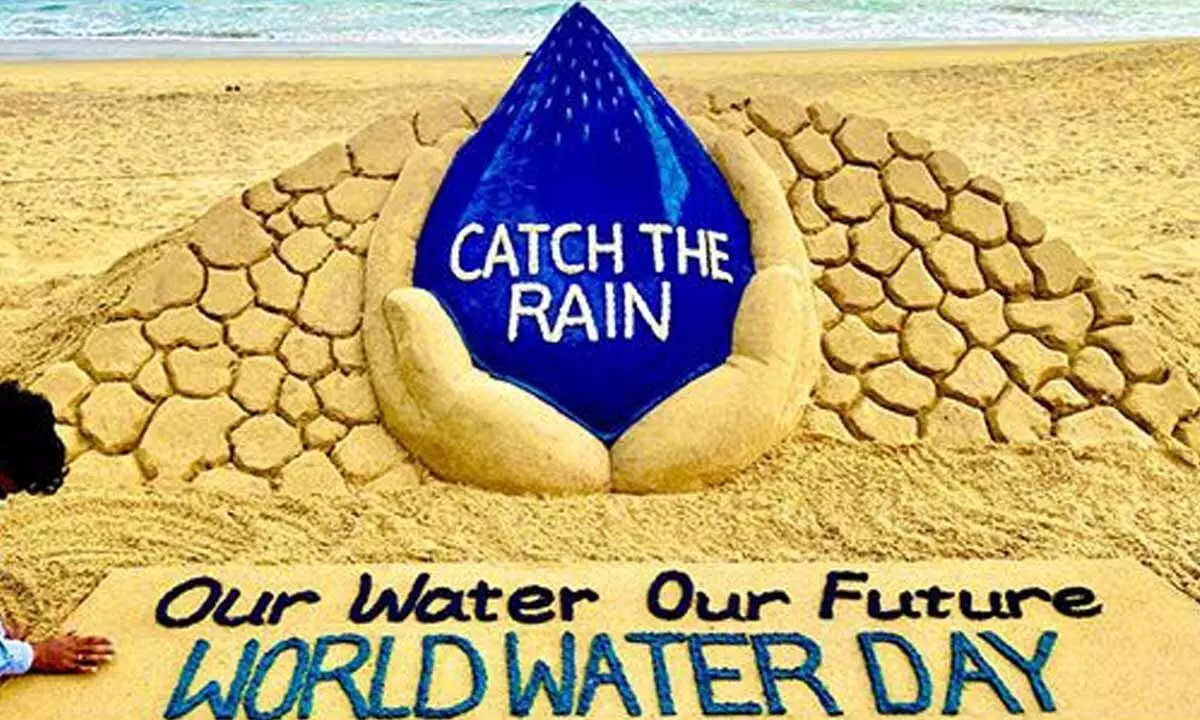Major drive to ease water stress

Water conservation through rainwater harvesting is one of the foremost priorities of the Government, stated Union Minister of State for Jal Shakti, Rajbhushan Choudhary, while giving a written reply to a question in Rajya Sabha on Monday.
Water conservation through rainwater harvesting is one of the foremost priorities of the Government, stated Union Minister of State for Jal Shakti, Rajbhushan Choudhary, while giving a written reply to a question in Rajya Sabha on Monday.
Major steps taken by the Government for water conservation and rainwater harvesting to reduce water stress in the country are as follows: Government of India has been implementing a scheme namely Mahatma Gandhi National Rural Employment Guarantee Scheme (MGNREGS) which inter-alia includes water conservation and water harvesting structures.
Financial assistance is given to various States under 15th Finance Commission tied grants which can be inter-alia utilized for rainwater harvesting.
The Ministry of Jal Shakti has been implementing Jal Shakti Abhiyan (JSA) since 2019 on an annual basis. In the current year, Ministry of Jal Shakti is implementing Jal Shakti Abhiyan: Catch the Rain (JSA: CTR) 2024, 5th in the series of JSAs, in all the districts (rural as well as urban) of the country. JSA: CTR is a convergence of various Central Government schemes and funds like MGNREGS, Atal Mission for Rejuvenation and Urban Transformation (AMRUT), Per Drop More Crop, Repair, Renovation and Restoration Components under the Pradhan Mantri Krishi Sinchai Yojana (PMKSY), Compensatory Afforestation Fund Management and Planning Authority (CAMPA), Finance Commission grants, State Government schemes, Corporate Social Responsibility (CSR) funds etc.
One of the major interventions undertaken under the campaign includes constructions and repair or rainwater harvesting structures including rooftop and water harvesting structures. Atal Mission for Rejuvenation and Urban Transformation (AMRUT) 2.0 has provisions for harvesting the rainwater through storm water drains into water body (which is not receiving sewage/effluent). Through preparation of ‘Aquifer Management Plan’ cities target to strategise groundwater recharge augmentation by developing a roadmap for improving rain water harvesting within city limits. Through IEC campaign, awareness is created about practices for water conservation like rainwater harvesting.
Ministry of Housing & Urban Affairs has formulated guidelines for the States to adopt measures suitable to local conditions, such as Unified Building Bye Laws (UBBL) of Delhi, 2016, Model Building Bye Laws (MBBL), 2016 and Urban and Regional Development Plan Formulation and Implementation (URDPFI) Guidelines, 2014 with adequate focus on requirement of rainwater harvesting and water conservation measures.
The Government of India is implementing Atal Bhujal Yojana, in 8,213 water stressed Gram Panchayats (GPs) in 80 districts of 7 States, viz., Haryana, Gujarat, Karnataka, Madhya Pradesh, Maharashtra, Rajasthan and Uttar Pradesh. The scheme marks a paradigm shift from groundwater development to groundwater management.
The Central government has been implementing “Pradhan Mantri Krishi Sinchai Yojana (PMKSY)” with an aim to enhance physical access of water on farm and expand cultivable area under assured irrigation, improve on farm water use efficiency, introduce sustainable water conservation practices etc. PMKSY has three components/ schemes namely Har Khet Ko Pani (HKKP), Repair, Renovation & Restoration (RRR) Scheme of Water Bodies and Surface Minor irrigation (SMI) Scheme.
The Ministry of Jal Shakti has set up the Bureau of Water Use Efficiency (BWUE) under the National Water Mission on 20.10.2022, to act as a facilitator for promotion of improving water use efficiency across various sectors namely irrigation, drinking water supply, power generation, industries, etc. in the country. Mission Amrit Sarovar was implemented in the recent times with provisions for creation/rejuvenation of at least 75 Amrit Sarovars in every district of the country with the purpose to harvest and conserve water.
Central Ground Water Board (CGWB) has completed the National Aquifer Mapping (NAQUIM) Project in the entire mappable area of about 25 lakh sq. km. which has been shared with the respective State agencies for implementation. The management plans include various water conservation measures through recharge structures.
CGWB has also prepared a Master Plan for Artificial Recharge to Groundwater- 2020 in consultation with States/UTs which is a macro level plan indicating various structures for the different terrain conditions of the country including estimated cost. The Master Plan has provisions for construction of about 1.42 crore Rain water harvesting and artificial recharge structures in the country to harness 185 Billion Cubic Metre (BCM) of monsoon rainfall.
CGWB, under Ground Water Management and Regulation Scheme, has also implemented several successful artificial recharge projects in the country for demonstrative purpose which enable the State Governments to replicate the same in suitable hydro-geological conditions.
National Water Policy (2012) has been formulated by Department of Water Resources, RD & GR, which inter-alia advocates rainwater harvesting and conservation of water and also highlights the need for augmenting the availability of water through direct use of rainfall.
Department of Land Resources (DoLR) implements Watershed Development Component of Pradhan Mantri Krishi Sinchai Yojana (WDC-PMKSY) for the development of rainfed and degraded lands in the country. The activities undertaken, inter-alia, include ridge area treatment, drainage line treatment, soil and moisture conservation, rainwater harvesting, nursery raising, pasture development, livelihoods for asset-less persons etc. WDC-PMKSY, through these interventions, seeks to ensure sustainable development through improved natural resource management and better resilience of farmers to climate change.
Water is a State subject and the Central Government supplements the efforts of the States through technical and financial support.














